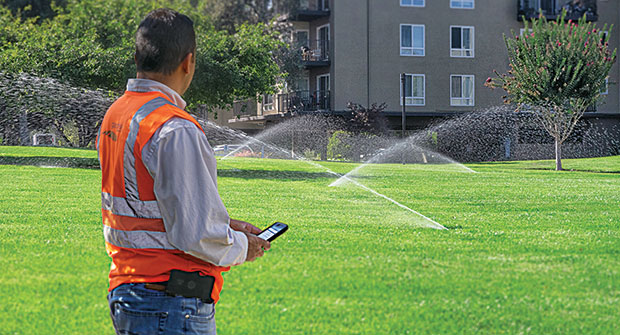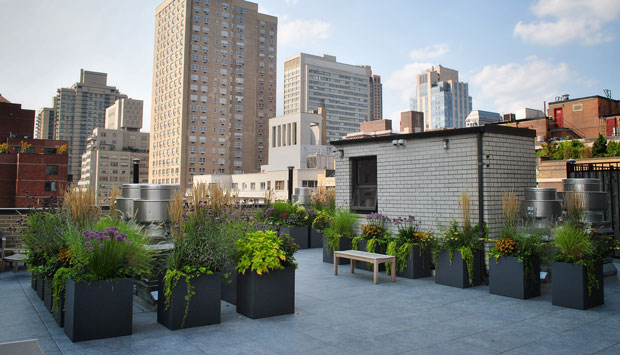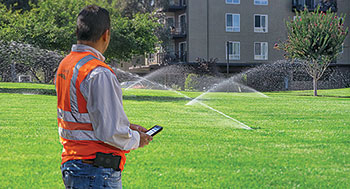
Gachina Landscape Management knows a thing or two about the importance of responsible water management. Located in Menlo Park, Calif. — in the heart of the San Francisco Bay Area — the company and many of its clients saw firsthand the impact of the drought and subsequent wildfires that raged throughout California during 2017 and 2018.
“We were impacted by the smoke, but just north of us, communities were devastated, and that forced us to look at what could be coming our way,” says Chad Sutton, water resource manager at Gachina.
During the last drought in California, Gov. Jerry Brown decreed a state of emergency, and water districts had to implement certain levels of water reduction. According to Sutton, almost all districts reached that reduction percentage by mandating how many days a week lawns could be irrigated.
“That was their one main reactionary measure that they take to control the use of water and to drive specific reduction targets,” he says. “But that can dramatically reduce the amount of water that we can apply.”
The company found itself permitted to irrigate only two days a week in an effort to get a 30 percent overall reduction in water use. Sutton says this caused problems, and Gachina turned to technology to help find solutions.
Using WeatherTrak controllers from HydroPoint, the company optimized irrigation by programing the maximum volume of water that could be applied and making sure the system used that amount throughout the water window.
According to Sutton, this kind of technology is going to be critical in the future because it allows the irrigation contractor to tell the controller to use exactly 30 percent less water but to get down as much water as theoretically possible.
“That for me is the solution,” he says. “The tech is going to help us apply the right amount of water even during those mandated restriction periods.”
Water is a finite resource, and for many irrigation companies — and not just those located in drought-prone states like California — doing more with less water has become an important part of their business model. Technology plays a large part in the reduction of waste and the responsible use of water to irrigate lawns and public spaces.
Begin with the basics
Sustainability means different things to different people in the irrigation industry, but they all have the same goal in mind: Eliminate water waste and use the resource in a responsible manner so it can be enjoyed by future generations.
As Sutton says, achieving sustainability when it comes to irrigation is much easier with the use of new technology. Companies don’t have to jump straight to installing new controllers, though. Finding sustainable solutions doesn’t have to include a massive overhaul of a client’s entire system right away.
In fact, it probably shouldn’t.
Before any new technology is installed, it’s important for contractors to ensure there are no leaks or breaks in an irrigation system. What good is a smart controller if customers are losing gallons of water every time they irrigate due to leaky valves?
Sutton views sustainability as eliminating waste because waste is the least sustainable of all scenarios.
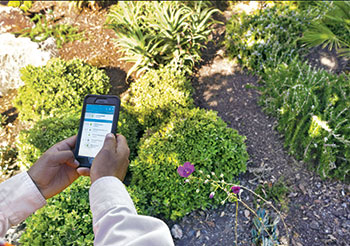
“Waste, for me, is leaks and breaks that are constantly wasting water on an irrigation system,” he says. “You’d be amazed how many of those are missed and let go when there is another sustainability initiative going on in the landscape.”
He adds that the first thing Gachina does is fix all leaks and breaks in a system, even though many clients want to jump straight to technology. “Before we start talking about smart controllers and spray-to-drip conversions, let’s go find that leak that’s costing you dollars every day.”
According to Russ Jundt, CEO of Conserva Irrigation, companies must have boots on the ground fixing inefficient systems before they can move on to technology.
“You’ve got seven broken heads and three broken nozzles,” he says. “We’re going to fix that first, then we will move on to better design issues, then we will move on to smart controllers. You’ve got to start with the basics.”
For Jundt, sustainability means making sure water resources last a lifetime. Jundt is based in Minnesota, an area of the country where drought may not seem quite as severe as it does for his peers in California. However, he is concerned about the rate at which water is being consumed.
Minnesota is the “land of 10,000 lakes,” but a lot of water doesn’t make it back into those lakes as cities grow and spread and sewer systems direct runoff into the Mississippi River and down to the Gulf of Mexico, he says. The dropping water table troubles him.
At Stay Green, in Santa Clarita, Calif., crews go through the irrigation system first to see what’s working and what’s not working and to give the client options, says Grant Clack, branch manager. He says there are rebates that clients can take advantage of, and if they can benefit from those, the company wants to make sure they do.
“We’ll go through the whole system first and then give them solutions to those problems,” he says.
Clack says sustainability is about three things: saving money, saving water and finding solutions to irrigation problems like old, tired systems that haven’t been updated in years.
Technology talk
After issues with the system have been addressed, companies can move on to installing technology that will help further maximize water efficiency and increase sustainability.
Technology can incorporate several different components, and irrigation companies have many options at their fingertips for decreasing their clients’ water use.
According to Jundt, the biggest advent in technology is a fairly simple one: the Toro PSN, high-efficiency spray nozzle.
“I liken it to replacing an incandescent lightbulb with a high-efficiency LED bulb,” he says. “That’s what this does. Take out the highly inefficient nozzle and screw this one in, and instantly you have 55 percent and up in water savings. It’s simple. Every house has 20, 30, 40 wasting nozzles on their property. It’s a better delivery of the water, and it uses less water.”
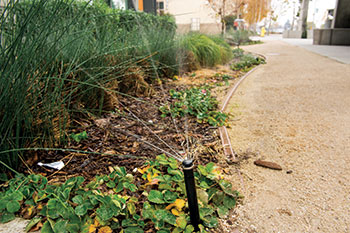
For Warren Gorowitz, director of corporate social responsibility at Hunter Industries, sustainability is all about reducing the impact on the environment. Smart irrigation controller technology is one way to do this, he says, because it takes the guesswork out of irrigation scheduling.
“(It) takes into consideration environmental conditions, which could be soil moisture sensors, ET sensors and rainfall and automatically adjust irrigation run times and frequency based on local weather conditions,” he says.
Cory Flippin, divisional manager for Andy’s Sprinkler, Drainage & Lighting in Dallas says the controller systems are a major part of the water conversation and sustainability. When using the correct controller, the company is able to prevent water waste by entering accurate information to allow for evapotranspiration rates on a specific landscape depending on the region, he says.
“It also allows for seasonal adjustments and prevents water cycles prior to rain events to avoid unnecessary watering after a noticeable rainfall event,” he adds.
According to Sutton, smart technology and weather-based controllers are the No. 1 way a company can reach its sustainability goals.
“There’s not much out there that can really drive sustainability goals other than that,” he says. “The other thing that trumps that is where can we eliminate irrigation.”
Switching customers to new controllers can save water, but the initial investment could cost a bit of green. On average, a new smart controller will cost a contractor about $200 to $250. Many municipalities, however, offer rebates encouraging customers to switch smart irrigation technology.
According to Sutton, the water districts are the biggest advocate for switching to updated technology, and they try to give people the monetary incentive to do so.
He says water districts in his area provide rebates that allow customers to swap out old controllers for weather-based models. “We have rebates that typically offset anywhere from 10 to 35 percent of a project’s costs. A lot of our sites can qualify for up to $20,000 to $50,000 (in rebates). We’ve probably helped our (commercial) clients get a million dollars’ worth of rebates.”
Clack echoes Sutton and encourages companies to take advantage of rebates and to take advantage of technology in general. Stay Green is currently in the process of converting its clients to Weathermatic controllers.
“Look for water-efficiency rebate programs from your local water provider — incentives for irrigation upgrades and in some cases landscape upgrades that can help offset costs to improve water efficiency of your irrigation system and/or landscape,” Gorowitz says.
It’s not all about controller technology.
Ron Wolforth, corporate communications manager at Rain Bird, emphasizes the importance of pressure regulation in products. It’s necessary to apply the right amount of pressure in order to reduce losses due to wind drift or evaporation because too much pressure makes the water droplets too small and more susceptible to blowing away, he notes.
One important technology that Stay Green has incorporated that removes drifting or evaporation from the equation entirely is drip irrigation. Using Netafim and Rain Bird drip systems, the team at Stay Green is able to apply water directly to where it is needed without worrying about runoff or drift.
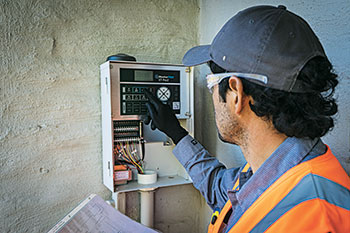
Beyond technology
Technology is not the only answer to sustainable water management. There are many other adjustments irrigation contractors can implement that can help their customers get the most out of their irrigation systems, while at the same time consuming fewer resources.
Jundt says that training employees is a major part of ensuring sustainable irrigation systems. If employees are properly trained, they will strive to install and maintain systems that work efficiently and effectively.
“By the advent of Google and YouTube and the advances of the Irrigation Association, you have resources readily available at your fingertips,” he says. “Additionally, you have access to training programs provided by your distributors: SiteOne or Ewing, whatever you’re choosing.”
Gorowitz encourages companies to send their employees to training programs. He says to participate in training opportunities and certification programs offered through the Irrigation Association and the Qualified Water Efficient Landscaper program.
“I think that the most important thing someone starting out needs to do is get training,” Wolforth adds. “They’re not just selling a landscape; they’re selling their expertise. So, getting trained and getting that expertise will allow them to know what is efficient and be able to sell that to their customers.”
It isn’t just about educating employees, however. It is also important to educate customers so they understand the importance of water management.
“Provide them with information for how much water is used on their landscape,” Gorowitz says. “Most of the time, water bills are not equated to outdoor water use, and so customers may not truly understand how much water they are using outside.”
According to Sutton, the contractor’s No. 1 job is to educate and open clients’ eyes to what is possible with irrigation.
There are actions contractors can take beyond education. Clack recommends changing the plant palette. If what is planted requires too much water in a given environment, consider planting something that will thrive without as much irrigation.
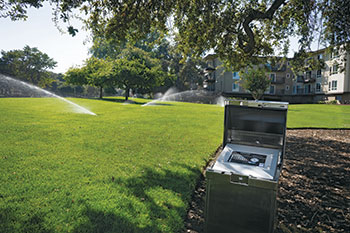
Flippin advises contractors to pay close attention to local rules and regulations. “Many Texas cities have adapted the state standard sprinkler rules, and they are forcing these rules to be implemented in each and every new sprinkler installation,” he says. “With these new regulations followed properly, water runoff and watering during rain events is prevented.”
Ultimately, ensuring responsible use of water falls on the shoulders of every irrigation contractor, no matter how large or small. The resources are available that fit into almost any company operating with any budget.
“Our water supply is finite,” Gorowitz says. “As the original green industry, we need to be good stewards of both the environment and water resources.”
